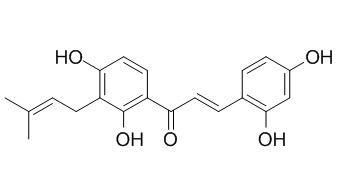Morachalcone A
Morachalcone A displays significant tyrosinase inhibitory activity (IC50, 0.013 uM); it also exerts strong pancreatic lipase inhibition with IC 50 value of 6.2 uM. Morachalcone A exhibits neuroprotective effects on HT22-immortalized hippocampal cells against glutamate-induced oxidative stress, with EC50 values of 35.5±2.1 uM. It exhibits potent inhibitory activity on nitric oxide production in RAW264.7 LPS-activated mouse macrophage cells with IC50 value of 16.4 microM.
Inquire / Order:
manager@chemfaces.com
Technical Inquiries:
service@chemfaces.com
Tel:
+86-27-84237783
Fax:
+86-27-84254680
Address:
1 Building, No. 83, CheCheng Rd., Wuhan Economic and Technological Development Zone, Wuhan, Hubei 430056, PRC
Providing storage is as stated on the product vial and the vial is kept tightly sealed, the product can be stored for up to
24 months(2-8C).
Wherever possible, you should prepare and use solutions on the same day. However, if you need to make up stock solutions in advance, we recommend that you store the solution as aliquots in tightly sealed vials at -20C. Generally, these will be useable for up to two weeks. Before use, and prior to opening the vial we recommend that you allow your product to equilibrate to room temperature for at least 1 hour.
Need more advice on solubility, usage and handling? Please email to: service@chemfaces.com
The packaging of the product may have turned upside down during transportation, resulting in the natural compounds adhering to the neck or cap of the vial. take the vial out of its packaging and gently shake to let the compounds fall to the bottom of the vial. for liquid products, centrifuge at 200-500 RPM to gather the liquid at the bottom of the vial. try to avoid loss or contamination during handling.
Nat Prod Sci.2016, 22(2)
Food Chemistry2023, 137837.
Antioxidants (Basel).2024, 13(12):1530.
Sains Malaysiana2024, 53(2):397-408.
J. Mater. Life Sci.2024, 3:2:78-87
Kyung Hee University2024, 4789969.
Front Cell Dev Biol.2021, 9:764263.
Molecules.2022, 27(2):451.
Korean J. Agricultural Science2024, 51(3).
J Agric Food Chem.2020, 68(43):12164-12172.
Related and Featured Products
J Med Food. 2015 Apr;18(4):403-8.
Neuroprotective effect of prenylated arylbenzofuran and flavonoids from morus alba fruits on glutamate-induced oxidative injury in HT22 hippocampal cells.[Pubmed:
25514545]
A prenylated arylbenzofuran and six flavonoids were isolated from the fruits of Morus alba L. through silica gel, octadecyl silica gel, and Diaion HP-20 column chromatography.
METHODS AND RESULTS:
Based on the nuclear magnetic resonance, mass spectrometry, and infrared spectroscopic data, the chemical structures of the compounds were determined to be artoindonesianin O (1), isobavachalcone (2), Morachalcone A (3), quercetin (4), astragalin (5), isoquercetin (6), and rutin (7). The isolated compounds were evaluated for protection of HT22-immortalized hippocampal cells against glutamate-induced oxidative stress.
CONCLUSIONS:
Compounds 1 and 3 exhibited protective effects with EC(50) values of 19.7±1.2 and 35.5±2.1 μM, respectively. The major compounds 1-3 and 7 were quantified using liquid chromatography/mass spectrometry analysis and were determined to be 1.88±2.1, 1.90±1.8, 0.78±1.5, and 37.29±2.2 mg/kg, respectively, in the ethanol extract of M. alba L. fruits.
J Nat Prod. 2012 Nov 26;75(11):1951-5.
Tyrosinase inhibitors from the wood of Artocarpus heterophyllus.[Pubmed:
23113717 ]
METHODS AND RESULTS:
From the methanolic-soluble extract of the wood of Artocarpus heterophyllus, four new flavones, artocarmins A-D (1-4), and three new chalcones, artocarmitins A-C (5-7), have been isolated together with 13 known compounds. Their structures were determined on the basis of the spectroscopic data.
CONCLUSIONS:
Compounds 1-4, 6, 7, 9-16, and 20 displayed significant tyrosinase inhibitory activity. The most active compound, Morachalcone A (12) (IC50, 0.013 μM), was 3000 times more active as a tyrosinase inhibitor than a positive control, kojic acid (IC50, 44.6 μM).
Bioorg Med Chem Lett. 2015 Jun 1;25(11):2269-74.
Pancreatic lipase inhibitory constituents from Morus alba leaves and optimization for extraction conditions.[Pubmed:
25935644]
The leaves of Morus alba (Moraceae) have been traditionally used for the treatment of metabolic diseases including diabetes and hyperlipidemia. Thus, inhibitory effect of M. alba leaves on pancreatic lipase and their active constituents were investigated in this study.
METHODS AND RESULTS:
Twenty phenolic compounds including ten flavonoids, eight benzofurans, one stilbene and one chalcones were isolated from the leaves of M. alba. Among the isolated compounds, Morachalcone A (20) exerted strong pancreatic lipase inhibition with IC50 value of 6.2μM. Other phenolic compounds containing a prenyl group showed moderate pancreatic lipase inhibition with IC50 value of <50μM. Next, extraction conditions with maximum pancreatic lipase inhibition and phenolic content were optimized using response surface methodology with three-level-three-factor Box-Behnken design.
CONCLUSIONS:
Our results suggested the optimized extraction condition for maximum pancreatic lipase inhibition and phenolic content as ethanol concentration of 74.9%; temperature 57.4°C and sample/solvent ratio, 1/10. The pancreatic lipase inhibition and total phenolic content under optimized condition were found to be 58.5% and 26.2μg GAE (gallic acid equivalent)/mg extract, respectively, which were well matched with the predicted value.
J Nat Prod. 2006 Apr;69(4):719-21.
Prenylated flavonoids from the heartwood of Artocarpus communis with inhibitory activity on lipopolysaccharide-induced nitric oxide production.[Pubmed:
16643064 ]
METHODS AND RESULTS:
A new prenylated chalcone, 3' ',3' '-dimethylpyrano[3',4']2,4,2'-trihydroxychalcone (1), was isolated from the heartwood of Artocarpus communis. Two flavonoid derivatives, (-)-cycloartocarpin (9) and (-)-cudraflavone A (10), were isolated as new isomers. In addition, eight known flavonoids, isobacachalcone (2), Morachalcone A (3), gemichalcones B (4) and C (5), artocarpin (6), cudraflavone C (7), licoflavone C (8), and (2S)-euchrenone a(7) (11), were isolated and identified from this plant for the first time.
CONCLUSIONS:
Compounds 1-4, 6, and 11 exhibited potent inhibitory activity on nitric oxide production in RAW264.7 LPS-activated mouse macrophage cells with IC(50) values of 18.8, 6.4, 16.4, 9.3, 18.7, and 12.3 microM, respectively. The structure of compound 1 was elucidated by spectroscopic data analysis, including 1D and 2D NMR experiments.



